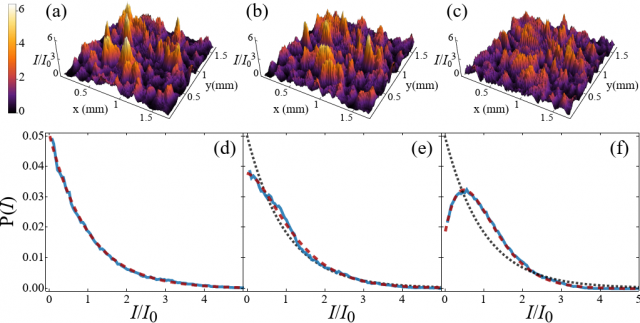This website uses cookies to ensure a better user experience.
To get more information, please read our Cookie Statement.
Nonequilibrium precondensation of classical waves
Nonequilibrium Precondensation of Classical Waves in Two Dimensions Propagating through Atomic Vapors
Neven Šantić, Adrien Fusaro, Sabeur Salem, Josselin Garnier, Antonio Picozzi, and Robin Kaiser
Physical Review Letters 120, 055301 (2018).
doi: 10.1103/PhysRevLett.120.055301
Bose-Einstein condensate (BEC) is a state of matter which occurs in a gas of indistinguishable particles called bosons at sufficiently low temperatures. It is characterized by a high fraction of the particles being in the quantum state with the lowest energy. BEC has been reported in a variety of quantum systems, such as ultracold atoms and molecules, exciton polaritons, and photons. An ensemble of classical waves can also exhibit a similar phenomenon of condensation with thermodynamic properties which are analogous to those of the genuine quantum BEC despite the classical nature of the system.
Neven Šantić from the Institute of Physics and colleagues from France published a paper in Physical Review Letters in which they observed the evolution of random waves with Gaussian statistics in two dimensions. The evolution is enabled by introducing a repulsive interaction between the waves in the form of a defocusing nonlinearity, with atomic vapor serving as an efficient nonlinear medium.

(a)-(c) Near field images for different interaction lengths and (d)-(f) the corresponding intensity histograms, showing the emergence of a non zero value for the maximum of P(I) with corresponding precondensation fractions n0: (d) n0 = 0, (e) n0/I0 = 0.5, (f) n0/I0 = 0.7. Dashed line represents a fit to theory with precondensation fraction as the sole free parameter.
Experimental and theoretical analysis of near field images reveal a phenomenon of precondensation that occurs far from thermal equilibrium and at short propagation lengths. Such a precondensation is in contrast to a complete thermalization to the Rayleigh-Jeans equilibrium distribution, requiring prohibitive long interaction lengths, and is characterized by a fast relaxation towards a precondensate fraction of up to 75%. These results pave the way to the study of the Berezinskii-Kosterlitz-Thouless transition in 2D, quantum fluids of light, or quench dynamics in the framework of the Kibble-Zurek mechanism.




